William Least Heat Moon
“Stop worrying about the potholes in the road and celebrate the journey .” Fitzhugh Mullan
We had programmed "Carla" for the drive south to Modica and she indicated that it would take about four and a half hours. From experience, we knew that meant probably at least 30 minutes longer as we tend to drive under the posted speed limit...there already enough crazies on the road and we don't need to add to the pile [up]. So we set off just before 8.00am. We were taking the autostradas all of the way, intending to avoid the slower provincial highways. That being said the first 20 kms were over provincial roads as we made our way to the entry point for the A3 [from Salerno to Reggio Calabria]. For the first 30 minutes of the drive, we struck fog but by the time that we got onto the A3, it had burnt off and it was clear skies from there south. [We understand that is quite a contrast to what NZ is experiencing at the moment...sorry, folks, don’t think we will offer a swap].
We were pleasantly surprised that the A3 was not tolled . However, in the final 40 kms, we struck an incredible amount of new work being done on the construction of new tunnels and viaducts. These people are serious road builders but then I guess that they have been doing it since the Romans so have had lots of practice. They make our Roads of National Significance programme look like a kindergarten schedule. There are separate tunnels for northbound and southbound traffic each with two normal lanes with a third lane for emergency vehicles The roads [and tunnels] are much wider than the ones they are replacing. The same with the viaducts...and these viaducts are huge. They have signs just before each tunnel/viaduct telling you how long it is. The longest tunnel we have struck so far is the 10.16 kms tunnel we went through on the way to L’Aquila about four weeks ago and I seem to recall a 1.7 km viaduct somewhere. Back to the A3, no doubt once the tunnels, viaducts and the linking highways are completed, they will again become tolled. In the meantime, they are free and we are thankful .
The ferry crossing was a pretty simple process. No pre-booking. Simply roll up with your car, buy your ticket and hop into the queue. Fortunately, we were able to drive straight on but even if you don’t make the cut on that one, there will be another in 40 minutes. They fill up pretty quickly and you can see why a bridge across the Straits was seriously being considered at one point. The latest on that issue is that the current Government has again cancelled the project so the ferries will continue to be the only mode of crossing. The water was glassy smooth, and amazingly clear, and the journey swift... 20 minutes after driving on from Calabria, we were driving off in Sicily. A very slick operation.
Initially the highway south of Messina was a little lumpy and there were many entry and exit ramps, probably the reasons that the speed limit was only 80 kmh. However, after about 10 kms things improved dramatically and the speed limit switched up to 130 kmh . That only meant that those who were simply using the speed limit as a guide were up around the 160 kmh mark. Lots of signs that tell you that the roads are being electronically monitored for speed but after 7000 kms, we have yet to see anyone pulled over for speeding. Maybe the fines arrive in the mail? We had to pay only one lot of highway tolls on the drive south and even that was minimal compared to mainland tolls. The final stretch from Catania down to Modica was toll free because while the highway itself had been constructed, the toll booths had not been built. Hopefully it will be no further advanced when we head across to Palermo in about two weeks' time.
The countryside is noticeably drier than we had been experiencing on the mainland and the sun has really returned with a vengeance. Yesterday was 28oC. Not that we are complaining. However, it makes it a bit of a challenge sorting out our suitcases. We had packed the warmer clothing in one of the bags and for about six weeks that bag remained unopened . Then we hit Puglia and the temperatures dropped so out came the winter clothing again. Now it's back in the suitcase and hopefully at least for our stay in Sicily that is where it will remain.
Our Modica apartment is a dream [and we have a fortnight here!!] We are on the slope of the valley about 50 metres above the main road through the city and directly opposite the Duomo. Handy if you like church bells...more later. However, the apartment has double glazing so that does help. The people here like to party on a little on Friday and Saturday nights but don’t seem to rely on alcohol to get in the party mood. Lots of talking, laughing, music, etc which reverberates around the city because there are lots of hard flat surfaces and very little to soften the noise. All a lot of fun and what makes city living exciting.
Our apartment which looks like every other one from the outside is stunning inside. It is a designer’s creation; guess we shouldn’t be too surprised about that because the owner works in Florence for Prada . Things we have seen in the house suggest that he attended a design school in Milan before joining Prada. It would be at least as big inside as our Wellington apartment but when the two huge patio areas are included, it would be much bigger. With everything being relatively new, it works, so that is a real plus after the last place where we had more on the "suggest you fix this” list to the landlord than we had on the "plusses" list. We have tried to be as honest as possible in our reviews of each place we have stayed in and a couple have made it very difficult to find positives to give the review balance. This place, however, we will have no difficulty unless it is to find a fault to report; after six days, we still haven’t found anything. It is the sort of place that we could squat in very comfortably for a couple of months...actually, that’s not a bad idea. [Will tuck it away for further consideration.]
Modica sits at the junction of two valleys [used to be river valleys ...more on that too, shortly]. The area of the high ground in between the valleys is Modica Alta [Upper Modica] with the confluence area being Modica Bassa [Lower Modica]. The apartment/house is in the Bassa area, as indicated above about halfway up the slope above Corso Umberto [the main street] and directly above and opposite the main church, San Pietro. The view from the balcony is stunning, day or night.
There is a third part to the city, Modica Sorda which translates to Modica Fricative [Word dictionary says Fricative means "describes a consonantal speech sound made by forcing the breath through a narrow opening"] ...not sure what that is all about unless it is a reference to a wind or something. The Sorda area sits astride the road to Syracuse.
The city's layout stems from the major earthquake back in 1693 which affected all of the cities and towns in south-eastern Sicily up to Catania about 100 kms away and was felt as far afield as Palermo on the other side of Sicily, and Rome on the mainland . Over 60,000 people killed, and cities and towns laid to waste all throughout the Val di Noto. Here in Modica, where over 3,400 were killed, the survivors were divided between those who wanted to re-build the old and those who wanted to build in a safer area. Hence, the Alta area [those who moved] and Bassa - those who stayed. Today they have merged back into one. [Sorda is a much more recent adaptation and grown separately from the two older areas.]
For a more extensive picture of what actually occurred, its consequences and the subsequent recovery/rebuild, check out this link: http://en.wikipedia.org/wiki/1693_Sicily_earthquake. The quake also created a tsunami which was felt as far away as Malta.
As indicated in an earlier report, the rebuilding happened to coincide with the arrival of the Baroque style of architecture and the architects and craftsmen were give a freer rein with their designs. Columns, arches, balconies, façades ...nothing was sacred in this elaborate new style which lavished buildings with complex shapes, extravagant ornaments, opulent paintings, and bold contrasts. A burst of life after the staid, restrained conservatism of the Renaissance period. So there was a bit of a feeding frenzy among the designers, each trying to be a little more flamboyant than the last.
Modica, Caltigirone, Ragusa, Scicli, Militello val di Catania, Palazzolo Acreide, Noto, Syracuse and Catania - all received extensive re-modelling during this rebuilding period [all have more recently been added to the UNESCO Heritage Sites list]. At the time, Modica had been the administrative centre for the area so it came in for some significant work and this is evidenced in its two main churches. In the Bassa area, there is San Pietro, which has a wide flight of steps framing the life-sized statues of the Twelve Apostles. It also has a bell tower ...more on that soon. Not to be outdone, the upper town of Modica Alta has San Giorgio, a true gem with three tiers to its façade . It certainly makes a Baroque statement and is clearly a worthy contender for the use of the word "stunning". It is very similar to the main church [of the same name] in Ragusa Ibla and it is thought that they were both the creations of the architect Rosario Gagliardi.
Corso Umberto I – Modica's "main street" - runs along the line of what [until 1902] used to be a river, which had 19 watermills along its course. It had many bridges crossing it and the town was also known as the "Venice of the South". However, the river was subject to flooding and the flood of '02 was the last straw. In the early hours of 26 Sep 1902, the equivalent of six months' normal rain fell in Modica and the surrounding area within 20 minutes. In the subsequent flooding, 112 lives were lost and many buildings were badly damaged. The authorities reacted by diverting the river further upstream and building a road over the old river bed. So today, Modica has an uncharacteristically wide main street . The Corso is flanked by a series of palazzi [palaces], whose balconies are supported by buttresses depicting gargoyles, twisted heads and beasts. All very Baroque.
Back to the bell tower [and the bells]. Apart from Bologna with its prolonged 7.03 am/pm "Ave Maria" chimes, most church bells have tended to be the common old bong-bong-bong variety. Here in Modica, it is very different. At 7 am/pm, San Pietro [which is about 100 metres in a clear uninterrupted line from our apartment/house] starts up. [Has to be electronically controlled because I doubt bell ringers could either be so consistent or have such stamina]. We have counted twice to make sure that we were not imagining it - 50 bongs in quick succession followed by 8 more spaced bongs then a final 21 rapid bongs before a pause and a final single bong. At midday on Saturday, the city’s churches [must be about 10 involved] have a bit of a conversation [in bell speak, of course] using the same formula but at the end of each set, San Pietro gives a single loud bong as if to say " I hear you and acknowledge you ...but I am boss"'. The whole process goes on for about 10 minutes. We will check back next week to clarify whether this is a weekly event or maybe that last Saturday was something significant in their calendar. [Tuesday's sonata was a variation on Saturday's theme.]
Day trips this week have included:
- Ragusa - another split town following the 1693 quake. The old part of the city [Ragusa Ibla] still retains the narrow streets and character of the 17th Century and about 20 years ago was granted funding from the EU to give the place a bit of a scrub up before UNESCO placed it on its Heritage list. We mentioned earlier a similar splendid looking San Giorgio church to Modica’s in Ragusa Ibla’s main piazza. It is interesting that Ragusa and Modica both have churches ascribed to some chap who used to race around the countryside slaying mythical beasts - a pagan theme somewhat at odds with the teachings of the Church or is it supposed to be allegorical - maybe the dragon represents the earthquake and Georgie Boy is representing the will of the people to survive and rebuild...who knows...
- Noto - we had been to Noto on a previous visit to Sicily but that time it had been raining and at the end of the day, so it was nice to go back when we had more time and the weather was much kinder [28oC and not a cloud in sight]. The town did not disappoint. Pre-1693, Noto was located about 6 kms from its present location. The quake changed all of that by levelling the town so the authorities opted for a green fields solution - a new town on new ground. The design has the streets running in a clean grid north-south, east-west with the main streets being on the east-west line. This enabled them to maximize the sun in its passage across the sky [give or take a bit for seasonal variances]. The architecture, however, is quite magical and is a true expression of Baroque at its finest. The main street - another Corso Vittorio Emanuele [most towns have a street named after him and/or Garibaldi] - has three large piazzas along its route across the heart of the city, each with its own large church. They, and their accompanying suitably embellished palazzi, administration buildings and other buildings are quite stunning in their gold sandstone. We had a recommendation here in Noto from Sir Fred so stopped for lunch midway through the visit. Bad move...food was excellent but when we finished lunch, we found that the churches had closed shop for the afternoon and would not open again till 4 pm....bugger!!! Oh well, maybe the next time we are here.
- Oasi Faunistica de Vendicari - a nature reserve on the east coast near Noto. This area of the coast used to be big on tuna fishing up till the early 1800s then the waters started to be fished out and the tuna catch fell dramatically. By the late 1800s, most of the tuna factories had closed down. The Nature Reserve now incorporates one of the old factories as well as old salt pans which were no longer being used and a large slice of wetlands feeding into the area. Bird life is quite prolific, and includes cormorants, white herons and pelicans. We saw the first two but the pelicans were elsewhere for the day/week/duration. The other big plus of the reserve is that it protects the beaches from the developers. A day on the beach in this part of the world, particularly in summer, can be expensive. No such thing in Italy as the "queen’s chain" or public land; the beaches appear to belong to those who own the adjoining land and they charge a fee for you to lie on "their" sand. So the Nature Reserve has an added benefit - free beaches. And guess what - Stuey and Trish took advantage of it to take a dip in the Med. Water was crystal clear and very refreshing.
Well, that’s it again for another week. Fortunately, we have another week here in Modica in our dream home. Over the coming week, we will take in a trip to Syracuse which was at one time, the primary city/port in this part of the world given that it could influence the main trading routes through the area and a look at Scicli, another Baroque town. Might also catch some more beach time. So until next week...

 Modica, Sicily, Italy
Modica, Sicily, Italy


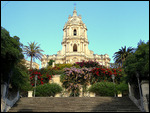
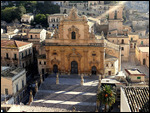
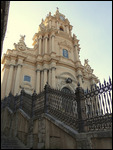
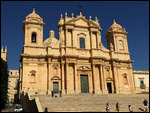


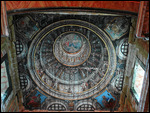

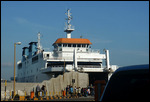






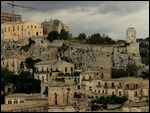
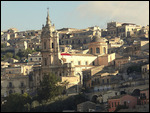

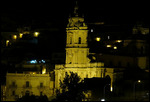
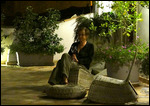
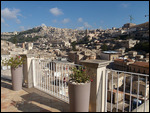
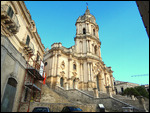
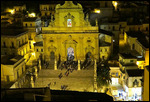

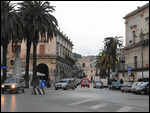


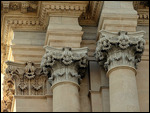


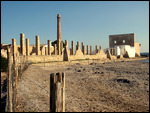
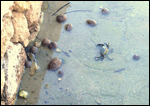




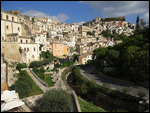
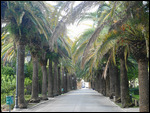
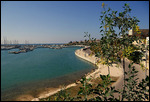
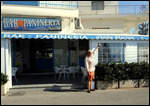
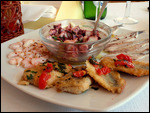


Peg
2013-10-30
All that seafood .We are very jealous. What a wonderful trip.